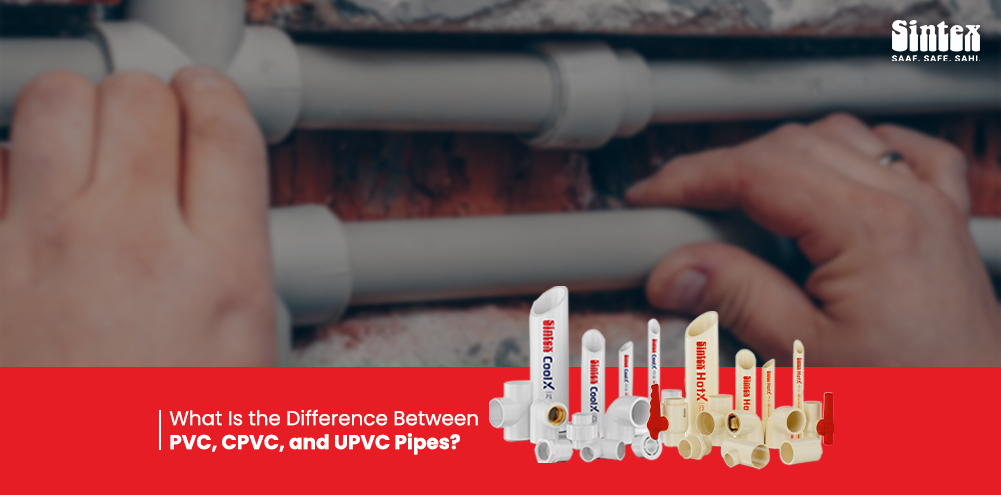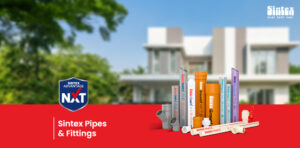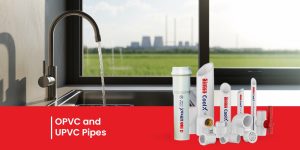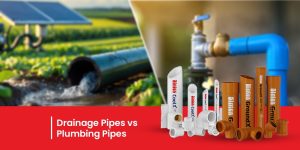What is the Difference Between PVC, CPVC, and UPVC Pipes?
Share

Table of Contents
This blog is all about explaining the differences between PVC, CPVC, and UPVC pipes and helping homeowners choose the right option for their water systems. It breaks down where each type works best—PVC for cold water and drainage, CPVC for hot and cold water, and UPVC for safe, durable cold water distribution and conduits. The blog also highlights Sintex HotX CPVC Plus for heat resistance and Sintex CoolX UPVC Plus for lead-free, antimicrobial safety, showing how Sintex products raise the bar for durability, hygiene and performance in modern plumbing solutions.
When you construct or renovate your home, you spend hours choosing tiles, lights, or wall paint. But have you ever thought of the pipes that go behind your walls? They are just as crucial, if not more. Whether it’s clean drinking water, a smooth hot water system, or durable drainage pipe, the pipes you choose matter the most.
That is why most homeowners and builders ask one simple question: what is the difference between CPVC pipes and PVC pipes, and where does UPVC stand?
Let us break down the PVC vs CPVC vs UPVC so you know exactly what is best for your home.
Why Understanding Pipe Types Matters
One size won’t fit all when it comes to pipes. What’s adequate for cold water may not stand up to heat. A pipe ideal for kitchen supply may not be adequate for exterior use. Being aware of PVC vs CPVC or UPVC vs CPVC keeps you from spending money on future replacements.
PVC Pipes Explained
PVC pipe is the most widely used plastic pipe. Inexpensive, lightweight, and simple to install, they’re commonly employed for drainage and cold water supply. PVC is soft but not ideal for hot water because it melts at an extreme temperature.
- Best for: Cold water, drainage, irrigation
- Limitations: Cannot handle high heat
- Advantage: Low cost and easy availability
CPVC Pipes Explained
CPVC pipes are an advanced version of PVC. The “C” indicates chlorinated, and due to that, the material is resistant to heat. That is, CPVC pipe & fitting can carry hot water safely up to about 93°C.
- Best for: Hot and cold water supply, residential and commercial use
- Limitations: Slightly more expensive than PVC
- Advantage: Heat resistance, long life, safe for potable water
At Sintex, we take this a step further with Sintex HotX CPVC Plus. These CPVC pipes have antimicrobial properties, thermal insulation, chlorine resistance, and UV protection. They’re built for strength under pressure and extreme heat, giving homes safety and durability.
UPVC Pipes Explained
UPVC pipes (unplasticised PVC) are another upgrade. Unlike PVC, they don’t contain plasticisers, making them stronger and more rigid. They’re widely used for cold water, electrical conduits, and industrial applications. Since they’re non-toxic and chemical-resistant, Sintex UPVC pipes are also great for drinking water.
- Best for: Cold water distribution, electrical conduits, industrial piping
- Limitations: Not suitable for hot water use
- Advantage: Lead-free, durable, non-toxic, fire-safe
Our Sintex CoolX UPVC Plus range is designed with lead-free technology, antimicrobial protection, UV stability and high-quality brass fittings. They’re ideal for efficient cold water systems, safe for families and trusted for long-term performance.
PVC vs CPVC vs UPVC: Key Comparisons
| Feature | PVC Pipes | CPVC Pipes | UPVC Pipes |
| Temperature Resistance | Cold water only | Cold + Hot water (up to 93°C) | Cold water only |
| Flexibility | Flexible but softens in heat | Rigid, heat-resistant | Rigid, more durable than PVC |
| Safety for Drinking Water | Safe, but not heat-stable | Safe, chlorine-resistant | Lead-free and safe |
| Common Uses | Drainage, irrigation, and cold water | Hot water, domestic supply, hotels | Cold water, conduits, industrial use |
| Cost | Cheapest | Slightly higher | Similar to CPVC, it varies by brand |
| Fire Resistance | Limited | Moderate | Excellent (does not support burning) |
This side-by-side comparison table clears up the PVC vs CPVC vs UPVC question. The choice depends on whether you need hot water capacity, high strength, or budget efficiency.
Where Sintex Products Fit In
We’ve developed our own advanced ranges of CPVC pipes, UPVC pipes, and fittings to meet modern demands:
- Sintex HotX CPVC Plus: With antimicrobial innovation, chlorine resistance, UV protection, and thermal insulation, this range redefines the durability of CPVC pipes & fittings. Perfect for hot water and high-pressure systems.
- Sintex CoolX UPVC Plus: A modern solution for cold water distribution. These Sintex UPVC pipes are lead-free, fire-safe, UV-stabilised, and have top-grade brass fittings. Ideal for homes, commercial setups, and safe drinking water.
With PVC vs CPVC vs UPVC, these product lines give you solid choices that meet the standard and raise new standards.
Tips for Choosing the Right Pipe
- Always go for CPVC pipes like Sintex HotX CPVC Plus for hot water systems.
- For cold water lines, UPVC vs CPVC often comes up, but if cost and safety are priorities, Sintex UPVC pipes are the smart pick.
- For general low-cost applications or drainage, PVC pipes still do the job well.
- Always check fittings and joints. Using high-quality CPVC pipes & fittings ensures leak-free performance.
Conclusion
The battle of PVC vs CPVC vs UPVC is not about which is better overall, but which is better for your needs. PVC pipes work for simple cold-water applications, CPVC pipes shine in hot water systems, and UPVC pipes stand out for cold water safety and durability.
At Sintex, we’ve developed these materials into reliable products such as HotX CPVC Plus and CoolX UPVC Plus to provide peace of mind, security, and enduring performance. Next time you’re making a decision, don’t just think about pipe price; think about durability and safety, too.
CPVC pipes are designed for hot water systems, especially premium ranges like Sintex HotX CPVC Plus.
UPVC pipes are lead-free and non-toxic, safe for potable water, particularly Sintex UPVC pipes, which are antimicrobial.
CPVC is slightly more costly because it is heat-resistant, but better in the long run.





